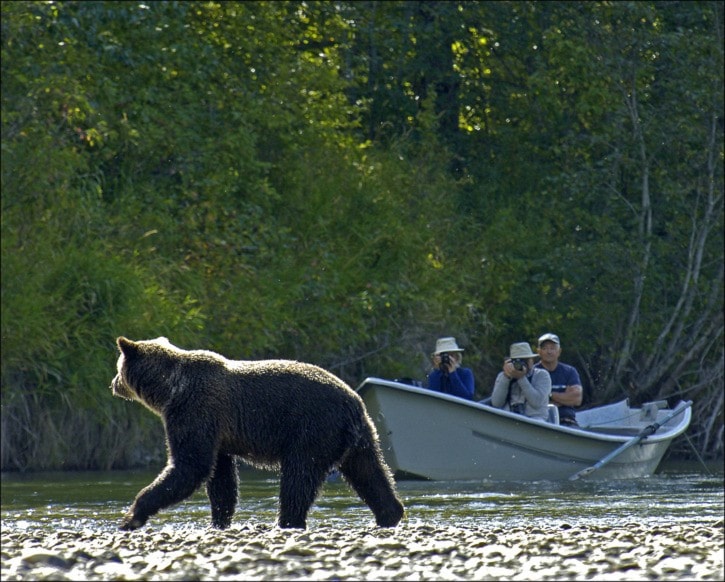A new study released last week claims that bear watching is much more profitable than bear hunting. The study was conducted by the Center for Responsible Travel (CREST), a non-profit research institute with offices in Washington, DC and at Stanford University.
Founded in 2003, CREST’s website states that their mission is to ‘promote responsible tourism policies and practices globally so that local communities may thrive and steward their cultural resources and biodiversity.’
Entitled ‘The Economic Impact of Bear Viewing and Bear Hunting in the Great Bear Rainforest of British Columbia,’ the study alleges that in 2012, bear viewing in the Great Bear Rainforest, which has been growing rapidly over the last decade, generated 12 times more in visitor spending than bear hunting and over 11 times in direct revenue for BC’s provincial government.
The study also states that bear-viewing companies directly employed an estimated 510 persons in 2012, while guide-hunting outfitters generated only 11 jobs that same year.
The study has been welcomed by those arguing that bear hunting is bad for the tourism business. The Coastal First Nations (CFN), a nine-member group that includes local nations such as the Nuxalk, Heiltsuk, Wuikinuxv, and Kitasoo-Xaixais, declared a ban on trophy hunting in their traditional territories in the fall of 2012. The group erected signs and patrolled the area during last year’s hunting season, asking bear hunters to leave.
CREST is calling on the B.C. government to reconsider its hunting policies in light of these findings, but so far the province has refused to change its policies.
Lead researcher, Martha Honey, said the report indicates that the province is putting more money into managing the hunt than it gets back. “It seemed to us quite clear that the government is spending more to sort of manage and oversee hunting than it is earning from revenue from hunting,” she said.
“This study reinforces what First Nations in the area have been saying for years,” said Kitasoo/Xai'xais councillor Doug Neasloss. “Bears are worth more alive than they are dead. That goes for our communities, the ecosystems on the coast, and now we find out it’s true for the B.C. government too.”
Ecotourism, including bear viewing, has grown rapidly over the past decade on B.C.'s Central Coast, said Honey. People from around the world come to the Great Bear Rainforest in the hopes of seeing black, grizzly and kermode bears in their natural habitat.
“I’ve worked as a bear viewing guide for the past three seasons,” said Jason Moody of the Nuxalk Nation. “Those numbers reflect what we’re seeing, for sure. There’s so much potential for tourism and hospitality, but trophy hunting is holding things back. And that makes it harder for First Nations to create jobs for our people that are in line with our laws and our traditions.”
While the government has not entered into a debate about the moral and ethical issues surrounding the grizzly bear hunt, a Ministry of Forests spokesperson said the ministry is disappointed in the report, claiming the study creates an artificial divide between bear viewing and hunting, which are not necessarily mutually exclusive activities.
Scott Ellis, president of the Guide Outfitters Association of B.C, agrees. “There’s no conflict between hunting and viewing. I don’t think the two things are incompatible,” he said.
“Absolutely we need a hunt,” says Ellis. “From my perspective, the bear population is fine, healthy, and growing. But bears like all other species need to be managed and hunting is one of the management tools.”
Last December the Ministry recently released a peer-reviewed study entitled “Predicting grizzly bear density in western North America,” which was co-authored by two provincial wildlife biologists and was published in the science journal PLOS ONE.
The aim of the report was to ‘provide further insight into grizzly populations in B.C.” The predictions are based on a model that generated population estimates for all areas of B.C. According to the model, B.C. is home to 13,131 grizzly bears.
The government claims that the study reaffirms that their management practices are sound and sustainable, stating that “grizzly bear harvest rates in British Columbia are set conservatively and well below what the population can sustain.” According to government numbers, hunters have historically killed around 300 grizzly bears a year out of an estimated population of 15,000, or a two per cent harvest rate.
However, a separate study published in the same science journal two months earlier challenges these latest findings, saying that the government’s methods of estimating populations are simply too inaccurate and the kill rates are too high, comparing the methods to a game of Russian roulette.
Based on an analysis of 10 years of government data, the study called on the government to reduce the quotas by at least 50 percent, claiming that in many regions where hunting is permitted, more grizzlies have been killed than even government targets allow. One of the authors of the study, SFU biologist Kyle Artelle, says that in at least one regional population, hunters killed 24 more bears than the local quota permitted.
Numbers, however, are not the heart of the issue for those concerned with the larger moral and ethical questions surrounding hunting an animal for sport and not food. As the government refuses to entertain these perspectives and chooses only to focus solely on the economic and scientific approach, it will be up to individuals to make their views known.
“This is an issue that needs to be addressed based on principles,” said Jess Housty, a councilor with the Heiltsuk Nation. “We really hope that the focus is on the heart of this issue.”
